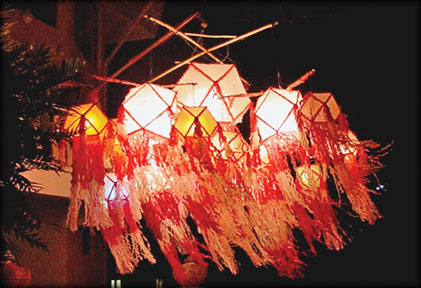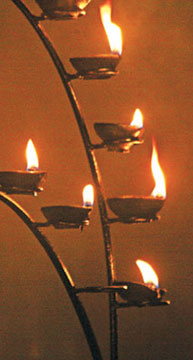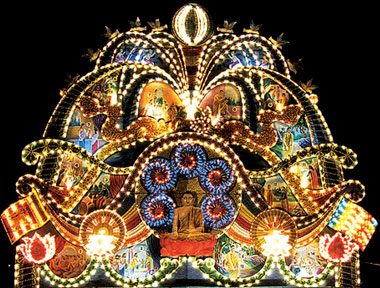Vesak as a festival of lights
by S. Weragoda
With the dawn of the 2556th year of the Buddhist calendar, reckoned
after the Passing Away of Sakyamuni Gautama Buddha, the world will mark
Vesak this week.
 |
|
Vesak lanterns are a
major attraction of the festivities |
The Vesak Poya is significant to Buddhists across the world as three
most significant events of the Buddha’s life occurred on a Vesak Full
Moon Poya day. They are the Birth of Prince Siddhartha Gautama, the
Enlightenment of ascetic Siddhartha Gautama and the Parinibbana (Passing
Away) of Gautama Buddha.
Vesak is a time which highlights the importance of Amisa Pooja, the
practice of dana (charity), making offerings to the Buddha in various
ways including alms-giving. Prathipaththi Pooja, on the other hand, is
when one practises Dhamma through seela (morality) and bhavana
(meditation). Sometimes, the two types of poojas are practised hand in
hand.
The festival of Vesak is also identified with Bhakthi Gee or
devotional songs. Clad in pure white or other light colours, both male
and female singers would sing the songs to elaborate the great virtues
of the Buddha. Bhakthi Gee recitals are organised by schools and
institutes as well as different companies and even the Armed Forces and
police.
Vesak marks the triple significant moments from the life of the
Enlightened One. It is also one of those rare times when Amisa Pooja is
witnessed at its best. Hence, there is no better time to set aside all
differences - racial, religious, ethnic and cultural - and relish the
blissful experience of the splendour of the Vesak festival in total
harmony.
Dazzling illuminations
While dansalas are set up in most cities to generously serve local
food and beverages free, where the noble cause of alms-giving is
practised, the festival gains an added dimension at night with thorana
(pandals), Vesak lanterns, Buddhist flags, festoons and dazzling
illuminations where the Aloka Pooja or offering of light to the Buddha
is practised.
The Buddha’s teachings are compared to a lamp for those who are
groping in the darkness of ignorance. Those bhikkhus who have followed
the path laid down by the Buddha and achieved their release and hence
delivered themselves from samsaric darkness are described as
light-bringers (Aalokakara), torch-bearers (Ukkaadhaara) and
darkness-dispellers (Tamonuda) in the Itivuttaka (p-108).
 |
|
Offerings of light at
temples |
A recurrent passage highlights this idea at the end of most of the
Buddha’s discourses by comparing the exposition, concerned as “holding a
lamp in darkness so that those endowed with eyes could see (Andhakaare
tesapajjotam vaa dhaareyya). The Buddha is thus referred to as holding
aloft the torch of the Dhamma to the entire world, thereby spreading
light and eyesight to humanity.
Light and wisdom
Light offering has today become so popular that Vesak illuminations
commemorating the Birth, Enlightenment and Passing Away of the Buddha
have turned out to be more or less a ‘festival of lights’, especially in
Sri Lanka, the home of Theravada Buddhism.
A pandal displays a story from the Buddha’s life, a Jataka tale or
historical events of the country. Offerings of light such as pahan or
Aloka pooja have, in fact, become a common element among the popular
Buddhist rituals everywhere.
Unlike in the case of other aspects of Amisa Pooja, offering of light
through lamps has a special significance owing to the symbolism of light
and wisdom. Therefore, it is well and good that pahan pooja has become
the major element in the widely popular Bodhi pooja ritual of today.
This is so because it was under a Bo tree that the Buddha attained
Enlightenment by conquering all the forces of darkness and ignorance
that torment this world.
In this context, when lamps are lit as part of a Bodhi pooja, it
serves, not only as a memorial to the great event, but also as a
symbolic ritual whereby the performer also could expect to partake of at
least a minimal portion of that “light” attained by the Enlightened One.
In this sense, when performed with seriousness, devotion and confidence,
this ritual can be justifiably treated as a spiritual exercise.
Cetiya-worship also has Pahan pooja as an integral part, based on the
same logic.
Vesak lanterns of various kinds, shapes and colours are lit in
Buddhist homes on Vesak Day. Pandals, well-illuminated with electricity
and depicting various scenes from the Buddha’s life or from Jataka
stories, also constitute a way in which the Buddha is worshipped and
remembered by means of lights.
There is a stanza popularly used in Sri Lanka, when offering lit
lamps in the name of the Buddha:
Ghanasarappadittena - deepena tamadansinaa
Tilokadeepam sambuddham – poojayami tamnudam
 |
|
Colourful pandals
spring up everywhere during Vesak |
“I worship the fully Enlightened One, the dispeller of darkness, the
lamp of the three worlds, with this darkness-dispelling lamps well-lit
with camphor”.
Camphor in lamps
This stanza refers to lamps lit with camphor, ghanasaara is a
Sanskrit word meaning camphor, this word seems to be absent in Pali, in
which language this stanza is composed. One could interpret this to mean
“lamps lit with camphor” to mean that camphor was used to light up the
lamp. But, it would be more correct to take the stanza to mean offering
lit camphor which is also used as a light-offering to the Buddha. The
burning camphor flame is said to be very pure unlike its smoke which is
a very powerful blackening agent.
In the above context, it would be better to confine the above-quoted
stanza to offer lit camphor and to substitute the word Telapajjota for
Ghanasarappa when offering oil-lamps, which has become the commonest
form of light-offering today.
State-sponsored events take place across the country with the
participation of the Maha Sangha, Dasa Sil Mata and the laity with
non-Buddhists joining their Buddhist fraternity at vihara, upasikarama
and other Buddhist centres. Vesak goes beyond Dana, Sila, Bhavana in
vihara and upasikarama to decorations and pandals in the towns and
cities.
The United Nations gave credence to the international recognition of
the Day of Vesak at the 54th Session of the UN General Assembly,
following a proposal by Sri Lanka. Vesak celebrations are now held at
United Nations offices throughout the world.
|


